Tiger
| Panthera tigris Temporal range: early Pleistocene–Recent | |
|---|---|
 | |
| A Bengal tiger (P. tigris tigris) | |
| Scientific classification | |
| Kingdom: | Animalia |
| Phylum: | Chordata |
| Clade: | Synapsida |
| Class: | Mammalia |
| Order: | Carnivora |
| Family: | Felidae |
| Subfamily: | Pantherinae |
| Genus: | Panthera |
| Species: | P. tigris |
| Binomial name | |
| Panthera tigris (Linnaeus, 1758) | |
| Subspecies | |
|
P. t. tigris | |
 | |
| Tiger's historic range in about 1850 (pale yellow) and in 2006 (in green).[2] | |
| Synonyms | |
|
Tigris striatus Severtzov, 1858 | |
The tiger (Panthera tigris) is the largest cat species, most recognisable for their pattern of dark vertical stripes on reddish-orange fur with a lighter underside. The species is classified in the genus Panthera with the lion, leopard, jaguar and snow leopard. Tigers are apex predators, primarily preying on ungulates such as deer and bovids. They are territorial and generally solitary but social animals, often requiring large contiguous areas of habitat that support their prey requirements. This, coupled with the fact that they are indigenous to some of the more densely populated places on Earth, has caused significant conflicts with humans.
Tigers once ranged widely across Asia, from Turkey in the west to the eastern coast of Russia. Over the past 100 years, they have lost 93% of their historic range, and have been extirpated from southwest and central Asia, from the islands of Java and Bali, and from large areas of Southeast and Eastern Asia. Today, they range from the Siberian taiga to open grasslands and tropical mangrove swamps. The remaining six tiger subspecies have been classified as endangered by the International Union for Conservation of Nature (IUCN). The global population in the wild is estimated to number between 3,062 and 3,948 individuals, down from around 100,000 at the start of the 20th century, with most remaining populations occurring in small pockets isolated from each other, of which about 2,000 exist on the Indian subcontinent.[4] A 2016 global census estimated the population of wild tigers at approximately 3,890 individuals.[5][6] Major reasons for population decline include habitat destruction, habitat fragmentation and poaching. The extent of area occupied by tigers is estimated at less than 1,184,911 km2 (457,497 sq mi), a 41% decline from the area estimated in the mid-1990s. In 2016, wildlife conservation group at WWF declared that world's count of wild tigers has risen for the first time in a century.[7]
Tigers are among the most recognisable and popular of the world's charismatic megafauna. They have featured prominently in ancient mythology and folklore, and continue to be depicted in modern films and literature. They appear on many flags, coats of arms, and as mascots for sporting teams. The tiger is the national animal of Bangladesh, India, Malaysia and South Korea.
Taxonomy and etymology
In 1758, Linnaeus described the tiger in his work Systema Naturae and gave it the scientific name Felis tigris.[3] In 1929, the British taxonomist Reginald Innes Pocock subordinated the species under the genus Panthera using the scientific name Panthera tigris.[8]
The word Panthera is probably of Oriental origin and retraceable to the Ancient Greek word panther, the Latin word panthera, the Old French word pantere, most likely meaning "the yellowish animal", or from pandarah meaning whitish-yellow. The derivation from Greek pan- ("all") and ther ("beast") may be folk etymology.[9]
The specific epithet, tigris, as well as the common name, tiger, come from the Middle English tigre and the Old English tigras (a plural word), both used for the animal.[10] These derive from the Old French tigre, itself a derivative of the Latin word tigris and the Greek word tigris. The original source may have been the Persian tigra meaning pointed or sharp and the Avestan tigrhi meaning an arrow, perhaps referring to the speed with which a tiger launches itself at its prey.[11]
Evolution

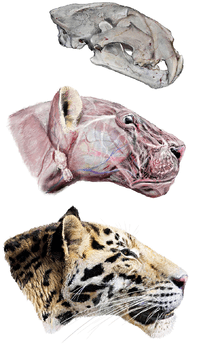
The tiger's closest living relatives were previously thought to be the lion, leopard and jaguar, all of which are classified under the genus Panthera. Genetic analysis indicates that the tiger and the snow leopard diverged from the other Panthera species about 2.88 million years ago, and that both species may be more closely related to each other than to the lion, leopard and jaguar.[12][13]
The oldest remains of an extinct tiger relative, called Panthera zdanskyi or the Longdan tiger, have been found in the Gansu province of northwestern China. This species is considered to be a sister taxon to the extant tiger and lived about 2 million years ago, at the beginning of the Pleistocene. It was smaller than the modern tiger, being the size of a jaguar, and probably did not have the same coat pattern. Despite being considered more "primitive", the Longdan tiger was functionally and possibly ecologically similar to its modern cousin. As Panthera zdanskyi lived in northwestern China, that may have been where the tiger lineage originated. Tigers grew in size, possibly in response to adaptive radiations of prey species like deer and bovids which may have occurred in Southeast Asia during the early Pleistocene.[14]
The earliest fossils of true tigers are from Java, and are between 1.6 and 1.8 million years old. Distinct fossils are known from the early and middle Pleistocene deposits in China and Sumatra. A subspecies called the Trinil tiger (Panthera tigris trinilensis) lived about 1.2 million years ago and is known from fossils found at Trinil in Java.[15]
Tigers first reached India and northern Asia in the late Pleistocene, reaching eastern Beringia (but not the American Continent), Japan, and Sakhalin. As evidenced by Sandra Herrington, some fossil skulls that are morphologically distinct from lion skulls could indicate however that tigers might have been present in Alaska within the last 100,000 years during the last glaciation.[16] Fossils found in Japan indicate the local tigers were, like the surviving island subspecies, smaller than the mainland forms, an example of insular dwarfism. Until the Holocene, tigers also lived in Borneo, as well as on the island of Palawan in the Philippines.[17]
The tiger's full genome sequence was published in 2013. It and other cat genomes were found to have similar repeat composition and an appreciably conserved synteny.[18]
Subspecies
There are 10 recognised tiger subspecies. One, the Trinil, became extinct in prehistoric times. The remaining subspecies all survived at least into the mid-20th century; three of these are also considered extinct. Their historical range in Bangladesh, Siberia, Iran, Afghanistan, India, China, and southeast Asia, including three Indonesian islands, is severely diminished today. The modern subspecies are:
| Subspecies | Description | Image |
|---|---|---|
| Bengal tiger (P. t. tigris), also called the Indian tiger | Lives in India, Nepal, Bhutan, and Bangladesh, and is the most common subspecies. In 2011, the total adult population was estimated at 1,520–1,909 in India, 440 in Bangladesh, 155 in Nepal and 75 in Bhutan.[19] In 2014, the population in India was estimated at 2,226,[20] 163–253 in Nepal and 103 in Bhutan as of 2015.[21] It lives in alluvial grasslands, subtropical and tropical rainforests, scrub forests, wet and dry deciduous forests, and mangroves. It is the second-largest of the surviving subspecies. Males attain a total nose-to-tail length of 270 to 310 cm (110 to 120 in) and weigh between 180 to 258 kg (397 to 569 lb), while females range from 240 to 265 cm (94 to 104 in) and 100 to 160 kg (220 to 350 lb).[22][23] In northern India and Nepal, the average is larger; males can weigh up to 235 kilograms (518 lb), while females average 140 kilograms (310 lb).[24] Coat colour varies from light yellow to reddish yellow with black stripes.[25]
|
 |
| Indochinese tiger (P. t. corbetti), also called Corbett's tiger | Is found in Cambodia, China, Laos, Burma, Thailand, and Vietnam. In 2010 the total population was estimated at about 350 individuals.[26] Their preferred habitat is forests in mountainous or hilly regions.[22] Males average 108 inches (270 cm) in total length and weigh between 150–195 kg (331–430 lb), while females average 96 inches (240 cm) and 100–130 kg (220–290 lb).[27]
|
_832-714-(118).jpg) |
| Malayan tiger (P. t. jacksoni) | Exclusively found in the southern part of the Malay Peninsula. The last native wild tiger in Singapore was shot dead in 1930.[28] Was not considered a subspecies in its own right until a 2004 genetic analysis showed that they are distinct in mtDNA and micro-satellite sequences from the Indochinese subspecies.[29] As of 2014 the total population is estimated at fewer than 500 individuals,[30] though a new report from September that year estimated it at between 250 and 340 individuals.[31] Males range in total length from 190–280 cm (75–110 in) and weigh between 47.2 to 129.1 kg (104 to 285 lb), while females range from 180–260 cm (71–102 in) and 24 to 88 kg (53 to 194 lb).[32]
|
 |
| Siberian tiger (P. t. altaica), also known as the Amur tiger | Inhabits the Amur-Ussuri region of Primorsky Krai and Khabarovsk Krai in far eastern Siberia, with the exception of a small population in Hunchun National Siberian Tiger Nature Reserve in northeastern China, near the border of North Korea.[33][34] In 2005, there were 331–393 adult and subadult Siberian tigers in the region, with a breeding adult population of about 250 individuals. As of 2015, there an estimated population of 480-540 individuals in the Russian Far East.[35][36][37] It is the largest subspecies and ranks among the largest felids ever to have existed. Males have a head and body length of between 190–230 cm (75–91 in) and weigh between 180 to 306 kg (397 to 675 lb), while females average 160–180 cm (63–71 in) and 100 to 167 kg (220 to 368 lb). Tail length is about 60–110 cm (24–43 in).[22] Compared to other subspecies, Siberian tigers have thicker coats, paler hues, and fewer stripes in dark brown instead of black.[25][27][38]
|
 |
| South China tiger (P. t. amoyensis), also known as the Amoy or Xiamen tiger | Is the most critically endangered subspecies of tiger, and one of the 10 most endangered animals in the world.[27] Despite unconfirmed reports and some evidence of footprints, there has been no confirmed wild sighting in over 25 years, leading experts to consider it "functionally extinct", with the entire known population of roughly 65+ individuals held in captivity.[39][40] It is the second-smallest subspecies. Males range in total length from 230–260 cm (91–102 in) and weigh between 130 to 180 kg (290 to 400 lb), while females range from 220–240 cm (87–94 in) and 100 to 110 kg (220 to 240 lb). The South China tiger is considered to be the most ancient of the tiger subspecies and is distinguished by a particularly narrow skull, long muzzle nose, rhombus-like stripes and vivid orange colour.[27]
|
|
| Sumatran tiger (P. t. sumatrae) | Found only on the island of Sumatra, and is thus the last surviving of the three Indonesian island subspecies. Listed as a distinct subspecies as of 1998, when genetic testing revealed the presence of unique genetic markers, and is critically endangered.[41] As of 2014 the wild population is estimated at between 400 and 500, seen chiefly in the island's national parks.[42][43] It is the smallest of all living tigers. Males range in total length from 220 to 255 cm (87 to 100 in) and weigh between 100 to 140 kg (220 to 310 lb), while females range between 215 to 230 cm (85 to 91 in) and 75 to 110 kg (165 to 243 lb).[22] Their reduced size is an adaptation to the thick, dense forests and smaller prey in their native habitat. This subspecies also has the darkest coat, with more narrowly spaced stripes and a longer mane and beard.[27][38]
|
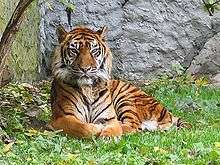 |
| Subspecies | Description | Image |
|---|---|---|
| Bali tiger (P. t. balica) | Was limited to the Indonesian island of Bali. Had a weight of 90–100 kg (200–220 lb) in males and 65–80 kg (143–176 lb) in females.[44] Bali tigers were hunted to extinction; the last Bali tiger, an adult female, is thought to have been killed at Sumbar Kima, West Bali, on 27 September 1937, though there were unconfirmed reports that villagers found a tiger corpse in 1963.[45] The Bali tiger is reported to have had some spots in between its stripes.[27]
|
 |
| Caspian tiger (P. t. virgata), also known as the Hyrcanian tiger or Turan tiger | Was found in the sparse forest habitats and riverine corridors west and south of the Caspian Sea and east through Central Asia into the Takla-Makan desert of Xinjiang, and had been recorded in the wild until the early 1970s.[46] The Siberian tiger is the genetically closest living relative of the Caspian tiger.[47]
|
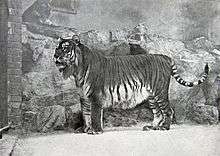 |
| Javan tiger (P. t. sondaica) | Was limited to the island of Java, and had been recorded until the mid-1970s.[48] Javan tigers were larger than Bali tigers; males weighed 100–141 kg (220–311 lb) and females 75–115 kg (165–254 lb).[49] After 1979, no more sightings were confirmed in the region of Mount Betiri.[50] An expedition to Mount Halimun Salak National Park in 1990 did not yield any definite, direct evidence for the continued existence of tigers.[51]
|
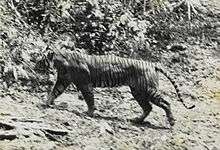 |
An analysis of craniodental and pelage morphology, ecology, and molecular biology of the tiger subspecies indicates that they have many traits in common and that the genetic diversity between them is low. The authors of this analysis suggest to group the Bengal, Indochinese, Malayan, South China, and Siberian tiger subspecies to the Continental tiger Panthera tigris tigris; and the Sumatran, Javan and Bali tiger subspecies to the Sunda tiger Panthera tigris sondaica. This classification is intended to facilitate tiger conservation management, both regarding breeding programmes in zoos and future translocations in the wild.[52] The classification is criticised by several geneticists, who maintain that the currently recognised nine subspecies can be distinguished genetically.[53]
Hybrids
Lions have been known to breed with tigers (most often the Amur and Bengal subspecies) to create hybrids called ligers and tigons. Such hybrids were once commonly bred in zoos, but this is now discouraged due to the emphasis on conservation. Hybrids are still bred in private menageries and in zoos in China.[54]
The liger is a cross between a male lion and a tigress.[55] Because the lion sire passes on a growth-promoting gene, but the corresponding growth-inhibiting gene from the female tiger is absent, ligers grow far larger than either parent. They share physical and behavioural qualities of both parent species (spots and stripes on a sandy background). Male ligers are sterile, but female ligers are often fertile. Males have about a 50% chance of having a mane, but, even if they do, their manes will be only around half the size of that of a pure lion. Ligers are typically between 10 and 12 feet in length, and can weigh between 800 and 1,000 pounds or more.[55]
The less common tigon is a cross between a lioness and a male tiger.[56] Because the male tiger does not pass on a growth-promoting gene and the lioness passes on a growth inhibiting gene, tigons are often relatively small, only weighing up to 150 kg (350 lb), which is about 10–20% smaller than lions. Like ligers, they have physical and behavioural traits from both parental species, and males are sterile. Females are sometimes fertile and have occasionally given birth to litigons when mated to a lion.[54]
Description

Tigers have muscular bodies with powerful forelimbs, large heads and long tails. The pelage is dense and heavy; colouration varies between shades of orange and brown with white ventral areas and distinctive vertical black stripes, whose patterns are unique to each individual.[22][57] Their function is likely for camouflage in vegetation such as long grass with strong vertical patterns of light and shade.[57][58] The tiger is one of only a few striped cat species; it is not known why spotted patterns and rosettes are the more common camouflage pattern among felids.[59] The tiger's stripes are also found on the skin, so that if it were to be shaved, its distinctive coat pattern would still be visible. They have a mane-like heavy growth of fur around the neck and jaws and long whiskers, especially in males. The pupils are circular with yellow irises. The small, rounded ears have a prominent white spot on the back, surrounded by black.[22] These false "eyespots", called ocelli, apparently play an important role in intraspecies communication.[60]
The skull is similar to that of the lion, though the frontal region is usually not as depressed or flattened, with a slightly longer postorbital region. The skull of a lion has broader nasal openings. However, due to variation in skulls of the two species, the structure of the lower jaw is a more reliable indicator of species.[61] The tiger also has fairly stout teeth; the somewhat curved canines are the longest among living felids with a crown height of up to 90 mm (3.5 in).[22]
The oldest recorded captive tiger lived for 26 years. A wild specimen, having no natural predators, could in theory live to a comparable age.[62]
Size
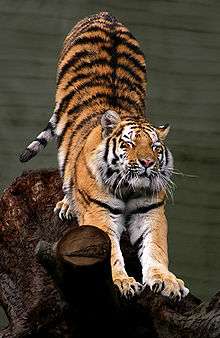
Tigers are the most variable in size of all big cats, much more so than lions.[63] The Bengal and Siberian subspecies are the tallest at the shoulder and thus considered the largest living felids, ranking with the extinct Caspian tiger among the biggest that ever existed.[64] An average adult male tiger from Northern India or Siberia outweighs an average adult male lion by around 45.5 kg (100 lb).[63] Males vary in total length from 250 to 390 cm (98 to 154 in) and weigh between 90 to 306 kg (198 to 675 lb) with skull length ranging from 316 to 383 mm (12.4 to 15.1 in). Females vary in total length from 200 to 275 cm (79 to 108 in), weigh 65 to 167 kg (143 to 368 lb) with skull length ranging from 268 to 318 mm (10.6 to 12.5 in).[65] The largest wild tiger ever reported had a total body length of 3.38 m (11.1 ft) over curves and weighed 388.7 kg (857 lb). In either sex, the tail represents about 0.6 to 1.1 m (24 to 43 in) of total length.[22]
Body size of different populations seems to be correlated with climate—Bergmann's rule—and can be explained by thermoregulation.[22] Large male Siberian tigers can reach a total length of more than 3.5 m (11.5 ft) over curves and 3.3 m (10.8 ft) between pegs, and can weigh up to 306 kg (675 lb). This is considerably larger than the weight of 75 to 140 kg (165 to 309 lb) reached by the smallest living subspecies, the Sumatran tiger. At the shoulder, tigers may variously stand 0.7 to 1.22 m (2.3 to 4.0 ft) tall.[44] The current record weight in the wild was 389 kg (858 lb) for a Bengal tiger shot in 1967.[64][66]
They are a notably sexually dimorphic species, females being consistently smaller than males. The size difference between males and females is proportionally greater in the larger tiger subspecies, with males weighing up to 1.7 times more than females.[67] Males also have wider forepaw pads than females, enabling gender to be told from tracks.[67]
Colour variations


A well-known allele found only in the Bengal subspecies produces the white tiger, a colour variant first recorded in the early 19th century and found in an estimated one in 10,000 natural births. Genetically, whiteness is recessive: a cub is white only when both parents carry the allele for whiteness.[68] It is not albinism, pigment being evident in the white tiger's stripes and in their blue eyes.[57] The causative mutation changes a single amino acid in the transporter protein SLC45A2.[69]
White tigers are more frequently bred in captivity, where the comparatively small gene pool can lead to inbreeding. This has given white tigers a greater likelihood of being born with physical defects, such as cleft palate, scoliosis (curvature of the spine), and strabismus (squint).[68] Even apparently healthy white tigers generally do not live as long as their orange counterparts. Attempts have been made to cross white and orange tigers to remedy this, often mixing with other subspecies in the process.[70]
Another recessive gene creates the "golden" or "golden tabby" colour variation, sometimes known as "strawberry". Golden tigers have thicker than usual light-gold fur, pale legs, and faint orange stripes. Few golden tigers are kept in captivity; they are invariably at least part Bengal. Some golden tigers carry the white tiger gene,[71] and when two such tigers are mated, they can produce some stripeless white offspring. Although a "pseudo-melanistic" effect—wide stripes that partially obscure the orange background—has been seen in some pelts, no true black tigers have been authenticated, with the possible exception of one dead specimen examined in Chittagong in 1846. These wholly or partially melanistic tigers, if they exist, are assumed to be intermittent mutations rather than a distinct species.[72][73] There are further unconfirmed reports of a "blue" or slate-coloured variant, the Maltese tiger. However, while some felids do exhibit this colouration as a solid coat, there is no known genetic configuration that would result in black stripes on a blue-gray background.[72]
Distribution and habitat

In the past, tigers were found throughout Asia, from the Caucasus and the Caspian Sea to Siberia and the Indonesian islands of Java, Bali and Sumatra. Fossil remains indicate tigers were also present in Borneo and Palawan in the Philippines during the late Pleistocene and Holocene.[74][75]
During the 20th century, tigers became extinct in western Asia and were restricted to isolated pockets in the remaining parts of their range. They were extirpated on the island of Bali in the 1940s, around the Caspian Sea in the 1970s, and on Java in the 1980s. This was the result of habitat loss and the ongoing killing of tigers and tiger prey. Today, their fragmented and partly degraded range extends from India in the west to China and Southeast Asia. The northern limit of their range is close to the Amur River in southeastern Siberia. The only large island they still inhabit is Sumatra.[1] Since the beginning of the 20th century, tigers' historical range has shrunk by 93%. In the decade from 1997 to 2007, the estimated area known to be occupied by tigers has declined by 41%.[2][76]
Tigers can occupy a wide range of habitat types, but will usually require sufficient cover, proximity to water, and an abundance of prey. Compared to the lion, the tiger prefers denser vegetation, for which its camouflage colouring is ideally suited, and where a single predator is not at a disadvantage compared with the multiple felines in a pride.[57] A further habitat requirement is the placement of suitably secluded den locations, which may consist of caves, large hollow trees, or dense vegetation.[62] Bengal tigers in particular live in many types of forests, including wet, evergreen, and the semievergreen of Assam and eastern Bengal; the swampy mangrove forest of the Ganges Delta; the deciduous forest of Nepal, and the thorn forests of the Western Ghats. In various parts of their range they inhabit or have inhabited additionally partially open grassland and savanna as well as taiga forests and rocky habitats.
Biology and behaviour

Social activity
Adult tigers lead largely solitary lives. They establish and maintain territories but have much wider home ranges within which they roam. Resident adults of either sex generally confine their movements to their home ranges, within which they satisfy their needs and those of their growing cubs. Individuals sharing the same area are aware of each other's movements and activities.[73] The size of the home range mainly depends on prey abundance, and, in the case of males, on access to females. A tigress may have a territory of 20 km2 (7.7 sq mi), while the territories of males are much larger, covering 60 to 100 km2 (23 to 39 sq mi). The range of a male tends to overlap those of several females, providing him with a large field of prospective mating partners.[77]
Unlike many felids, tigers are strong swimmers and often deliberately bathe in ponds, lakes and rivers as a means of keeping cool in the heat of the day. Among the big cats, only the jaguar shares a similar fondness for water.[78] They may cross rivers up to 7 km (4.3 mi) across and can swim up to 29 km (18 mi) in a day.[62] They are able to carry prey through or capture it in the water.
Young female tigers establish their first territories close to their mother's. The overlap between the female and her mother's territory reduces with time. Males, however, migrate further than their female counterparts and set out at a younger age to mark out their own area. A young male acquires territory either by seeking out an area devoid of other male tigers, or by living as a transient in another male's territory until he is older and strong enough to challenge the resident male. Young males seeking to establish themselves thereby comprise the highest mortality rate (30–35% per year) amongst adult tigers.[79]
To identify his territory, the male marks trees by spraying urine[80][81] and anal gland secretions, as well as marking trails with scat and marking trees or the ground with their claws. Females also use these "scrapes", as well as urine and scat markings. Scent markings of this type allow an individual to pick up information on another's identity, sex and reproductive status. Females in oestrus will signal their availability by scent marking more frequently and increasing their vocalisations.[82]
Although for the most part avoiding each other, tigers are not always territorial and relationships between individuals can be complex. An adult of either sex will sometimes share its kill with others, even those who may not be related to them. George Schaller observed a male share a kill with two females and four cubs. Unlike male lions, male tigers allow females and cubs to feed on the kill before the male is finished with it; all involved generally seem to behave amicably, in contrast to the competitive behaviour shown by a lion pride.[60] This quotation is from Stephen Mills' book Tiger, describing an event witnessed by Valmik Thapar and Fateh Singh Rathore in Ranthambhore National Park:[79]
A dominant tigress they called Padmini killed a 250 kg (550 lb) male nilgai – a very large antelope. They found her at the kill just after dawn with her three 14-month-old cubs and they watched uninterrupted for the next ten hours. During this period the family was joined by two adult females and one adult male, all offspring from Padmini's previous litters, and by two unrelated tigers, one female the other unidentified. By three o'clock there were no fewer than nine tigers round the kill.
Occasionally, male tigers participate in raising cubs, usually their own, but this is extremely rare and not always well understood. In May 2015, Amur tigers were photographed by camera traps in the Sikhote-Alin Bioshpere Reserve. The photos show a male Amur tiger pass by, followed by a female and three cubs within the span of about two minutes.[83] In Ranthambore, a male Bengal tiger raised and defended two orphaned female cubs after their mother had died of illness. The cubs remained under his care, he supplied them with food, protected them from his rival and sister, and apparently also trained them.[84][85]
Male tigers are generally more intolerant of other males within their territories than females are of other females. Territory disputes are usually solved by displays of intimidation rather than outright aggression. Several such incidents have been observed in which the subordinate tiger yielded defeat by rolling onto its back and showing its belly in a submissive posture.[86] Once dominance has been established, a male may tolerate a subordinate within his range, as long as they do not live in too close quarters.[79] The most aggressive disputes tend to occur between two males when a female is in oestrus, and may rarely result in the death of one of the males.[79][86]
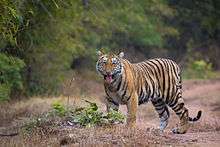
Facial expressions include the "defense threat", where an individual bares its teeth, flattens its ears and its pupils enlarge. Both males and females show a flehmen response, a characteristic grimace, when sniffing urine markings but flehmen is more often associated with males detecting the markings made by tigresses in oestrus. Like other Panthera, tigers roar, particularly in aggressive situations, during the mating season or when making a kill. There are two different roars: the "true" roar is made using the hyoid apparatus and forced through an open mouth as it progressively closes, and the shorter, harsher "coughing" roar is made with the mouth open and teeth exposed. The "true" roar can be heard at up to 3 km (1.9 mi) away and is sometimes emitted three or four times in succession. When tense, tigers will moan, a sound similar to a roar but more subdued and made when the mouth is partially or completely closed. Moaning can be heard 400 m (1,300 ft) away.[22] Chuffing, soft, low-frequency snorting similar to purring in smaller cats, is heard in more friendly situations.[87] Other vocal communications include grunts, woofs, snarls, miaows, hisses and growls.[22]
Tigers have been studied in the wild using a variety of techniques. The populations of tigers have been estimated using plaster casts of their pugmarks, although this method was criticised as being inaccurate.[88] More recent attempts have been made using camera trapping and studies on DNA from their scat, while radio collaring has been used to track tigers in the wild.[89] Tiger spray has been found to be just as good, or better, as a source of DNA as scat.[90]
Hunting and diet
_Ranthambhore_India_12.10.2014.jpg)

In the wild, tigers mostly feed on large and medium-sized animals, preferring native ungulates weighing at least 90 kg (200 lb).[91][92] They typically have little or no deleterious effect on their prey populations.[62] Sambar deer, chital, barasingha, wild boar, gaur, nilgai and both water buffalo and domestic buffalo, in descending order of preference, are the tiger's favoured prey in Tamil Nadu, India,[91] while gaur and sambar are the preferred prey and constitute the main diet of tigers in other parts of India.[93][94] They also prey on other predators, including dogs, leopards, pythons, sloth bears, and crocodiles. In Siberia, the main prey species are Manchurian wapiti and wild boar (the two species comprising nearly 80% of the prey selected) followed by sika deer, moose, roe deer, and musk deer.[95] Asiatic black bears and Ussuri brown bears may also fall prey to tigers,[44][96][97] and they constitute up to 40.7% of the diet of Siberian tigers depending on local conditions and the bear populations.[98] In Sumatra, prey include sambar deer, muntjac, wild boar, Malayan tapir and orangutan.[99][100] In the former Caspian tiger's range, prey included saiga antelope, camels, Caucasian wisent, yak, and wild horses. Like many predators, tigers are opportunistic and may eat much smaller prey, such as monkeys, peafowl and other ground-based birds, hares, porcupines, and fish.[91]
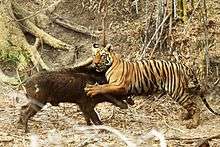
_with_Indian_Pangolin(Manis_crassicaudata)_Tadoba_Tiger_Reserve_Maharastra.jpg)
Tigers generally do not prey on fully grown adult Asian elephants and Indian rhinoceros but incidents have been reported.[101][102] More often, it is the more vulnerable small calves that are taken.[103] Tigers have been reported attacking and killing elephants ridden by humans during tiger hunts in the 19th century.[104] When in close proximity to humans, tigers will also sometimes prey on such domestic livestock as cattle, horses, and donkeys.[105] Old or wounded tigers, unable to catch wild prey, can become man-eaters; this pattern has recurred frequently across India. An exception is in the Sundarbans, where healthy tigers prey upon fishermen and villagers in search of forest produce, humans thereby forming a minor part of the tiger's diet.[106] Although almost exclusively carnivorous, tigers will occasionally eat vegetation for dietary fibre such as fruit of the slow match tree.[105]
Tigers are thought to be mainly nocturnal predators,[107] but in areas where humans are typically absent, they have been observed via remote-controlled, hidden cameras, hunting in daylight.[108] They generally hunt alone and ambush their prey as most other cats do, overpowering them from any angle, using their body size and strength to knock the prey off balance. Successful hunts usually require the tiger to almost simultaneously leap onto its quarry, knock it over, and grab the throat or nape with its teeth.[62] Despite their large size, tigers can reach speeds of about 49–65 km/h (30–40 mph) but only in short bursts; consequently, tigers must be close to their prey before they break cover. If the prey catches wind of the tiger's presence before this, the tiger usually abandons the hunt rather than chase prey or battle it head-on. Horizontal leaps of up to 10 m (33 ft) have been reported, although leaps of around half this distance are more typical. One in 2 to 20 hunts, including stalking near potential prey, ends in a successful kill.[62][109][110]
When hunting larger animals, tigers prefer to bite the throat and use their powerful forelimbs to hold onto the prey, often simultaneously wrestling it to the ground. The tiger remains latched onto the neck until its target dies of strangulation.[60] By this method, gaurs and water buffaloes weighing over a ton have been killed by tigers weighing about a sixth as much.[111] Although they can kill healthy adults, tigers often select the calves or infirm of very large species.[112] Healthy adult prey of this type can be dangerous to tackle, as long, strong horns, legs and tusks are all potentially fatal to the tiger. No other extant land predator routinely takes on prey this large on their own.[113][114] Whilst hunting sambars, which comprise up to 60% of their prey in India, tigers have reportedly made a passable impersonation of the male sambar's rutting call to attract them.[91][105] With smaller prey, such as monkeys and hares, the tiger bites the nape, often breaking the spinal cord, piercing the windpipe, or severing the jugular vein or common carotid artery.[115] Though rarely observed, some tigers have been recorded to kill prey by swiping with their paws, which are powerful enough to smash the skulls of domestic cattle,[105] and break the backs of sloth bears.[116]
During the 1980s, a tiger named "Genghis" in Ranthambhore National Park was observed frequently hunting prey through deep lake water, a pattern of behaviour that had not previously been witnessed in over 200 years of observations. Moreover, he appeared to be unusually successful, with 20% of hunts ending in a kill.[117]
After killing their prey, tigers sometimes drag it to conceal it in vegetative cover, usually pulling it by grasping with their mouths at the site of the killing bite. This, too, can require great physical strength. In one case, after it had killed an adult gaur, a tiger was observed to drag the massive carcass over a distance of 12 m (39 ft). When 13 men simultaneously tried to drag the same carcass later, they were unable to move it.[62] An adult tiger can go for up to two weeks without eating, then gorge on 34 kg (75 lb) of flesh at one time. In captivity, adult tigers are fed 3 to 6 kg (6.6 to 13.2 lb) of meat a day.[62]
Interaction with other predators

Tigers usually prefer to eat prey they have caught themselves, but are not above eating carrion in times of scarcity and may even pirate prey from other large carnivores. Although predators typically avoid one another, if a prey item is under dispute or a serious competitor is encountered, displays of aggression are common. If these are not sufficient, the conflicts may turn violent; tigers may kill competitors as leopards, dholes, striped hyenas, wolves, bears, pythons and crocodiles on occasion. Tigers may also prey on these competitors.[44][116][118][119][120][121] Attacks on smaller predators, such as badgers, lynxes, and foxes, are almost certainly predatory.[91] Crocodiles, bears and large packs of dholes may win conflicts against tigers and in some cases even kill them.[44][122][123][124]
The considerably smaller leopard avoids competition from tigers by hunting at different times of the day and hunting different prey.[125] In India's Nagarhole National Park, most prey selected by leopards were from 30 to 175 kg (66 to 386 lb) against a preference for prey weighing over 176 kg (388 lb) in the tigers. The average prey weight in the two respective big cats in India was 37.6 kg (83 lb) against 91.5 kg (202 lb).[126] With relatively abundant prey, tigers and leopards were seen to successfully coexist without competitive exclusion or interspecies dominance hierarchies that may be more common to the African savanna (where the leopard may coexist with the lion).[126] Lone golden jackals expelled from their pack have been known to form commensal relationships with tigers. These solitary jackals, known as kol-bahl, will attach themselves to a particular tiger, trailing it at a safe distance to feed on the big cat's kills.[127]
Reproduction
| Wikimedia Commons has media related to Mating tigers. |

Mating can occur all year round, but is more common between November and April.[62] A female is only receptive for three to six days. Mating is frequent and noisy during that time. Gestation can range from 93 to 112 days, the average being 105 days.[62] The litter is usually two or three cubs, occasionally as few as one or as many as six. Cubs weigh from 680 to 1,400 g (1.50 to 3.09 lb) each at birth, and are born blind and helpless.[62] The females rear them alone, with the birth site and maternal den in a sheltered location such as a thicket, cave or rocky crevice. The father generally takes no part in rearing them. Unrelated wandering male tigers may kill cubs to make the female receptive, since the tigress may give birth to another litter within five months if the cubs of the previous litter are lost.[62] The mortality rate of tiger cubs is about 50% in the first two years.[62] Few other predators attack tiger cubs due to the diligence and ferocity of the mother tiger. Apart from humans and other tigers, common causes of cub mortality are starvation, freezing, and accidents.[114]
A dominant cub emerges in most litters, usually a male.[117] This cub is more active than its siblings and takes the lead in their play, eventually leaving its mother and becoming independent earlier. The cubs open their eyes at six to fourteen days old. By eight weeks, the cubs make short ventures outside the den with their mother, although they do not travel with her as she roams her territory until they are older. The cubs are nursed for three to six months. Around the time they are weaned, they start to accompany their mother on territorial walks and they are taught how to hunt. The cubs often become capable (and nearly adult size) hunters at eleven months old.[62] The cubs become independent around eighteen months of age, but it is not until they are around two to two and a half years old that they fully separate from their mother. Females reach sexual maturity at three to four years, whereas males do so at four to five years.[62]
Conservation efforts
| Country | Estimate |
|---|---|
| 106 | |
| 103 | |
| 0 | |
| >7 | |
| 2,226 | |
| 371 | |
| 2 | |
| 250 | |
| no data | |
| 198 | |
| no data | |
| 433 | |
| 189 | |
| <5 | |
| Total | 3,890+ |
The tiger is an endangered species.[129] Poaching for fur and body parts and destruction of habitat have simultaneously greatly reduced tiger populations in the wild. At the start of the 20th century, it is estimated there were over 100,000 tigers in the wild, but the population has dwindled outside of captivity to between 1,500 and 3,500.[130][131] Major reasons for population decline include habitat destruction, habitat fragmentation and poaching.[1] Demand for tiger parts for use in traditional Chinese medicine has also been cited as a major threat to tiger populations.[132][133] Some estimates suggest that there are fewer than 2,500 mature breeding individuals, with no subpopulation containing more than 250 mature breeding individuals.[1] The global wild tiger population was estimated by the World Wide Fund for Nature at 3,200 in 2011 and 3,890 in 2015—Vox reported that this was the first increase in a century.[134][135] The exact number of wild tigers is unknown, as many estimates are outdated or are educated guesses; few estimates are based on reliable scientific censuses. The table shows estimates per country according to IUCN and range country governments.[129] The Wildlife Conservation Society and Panthera Corporation formed the collaboration Tigers Forever, with field sites including the world's largest tiger reserve, the 21,756 km2 (8,400 sq mi) Hukaung Valley in Myanmar. Other reserves were in the Western Ghats in India, Thailand, Laos, Cambodia, the Russian Far East covering in total about 260,000 km2 (100,000 sq mi).[136]
India is home to the world's largest population of wild tigers[137] but only 11% of the original Indian tiger habitat remains, and it has become fragmented.[138][139] From 1973, India's Project Tiger, started by Indira Gandhi, established over 25 tiger reserves in reclaimed land, where human development was forbidden. The project was credited with tripling the number of wild Bengal tigers from some 1,200 in 1973 to over 3,500 in the 1990s, but a 2007 census showed that numbers had dropped back to about 1,400 tigers because of poaching.[140] Following the report, the Indian government pledged $153 million to the initiative, set up measures to combat poaching, promised funds to relocate up to 200,000 villagers in order to reduce human-tiger interactions,[141] and set up eight new tiger reserves.[142] India also reintroduced tigers to the Sariska Tiger Reserve[143] and by 2009 it was claimed that poaching had been effectively countered at Ranthambore National Park.[144] A 2014 census estimated a population of 2,226, a 30% increase since 2011.[20]
In the 1940s, the Siberian tiger was on the brink of extinction with only about 40 animals remaining in the wild in Russia. As a result, anti-poaching controls were put in place by the Soviet Union and a network of protected zones (zapovedniks) were instituted, leading to a rise in the population to several hundred. Poaching again became a problem in the 1990s, when the economy of Russia collapsed. The major obstacle in preserving the species is the enormous territory individual tigers require (up to 450 km2 needed by a single female and more for a single male).[145] Current conservation efforts are led by local governments and NGO's in concert with international organisations, such as the World Wide Fund for Nature and the Wildlife Conservation Society.[146] The competitive exclusion of wolves by tigers has been used by Russian conservationists to convince hunters to tolerate the big cats. Tigers have less impact on ungulate populations than do wolves, and are effective in controlling the latter's numbers.[147] In 2005, there were thought to be about 360 animals in Russia, though these exhibited little genetic diversity.[35] However, in a decade later, the Siberian tiger census was estimated from 480 to 540 individuals.

Having earlier rejected the Western-led environmentalist movement, China changed its stance in the 1980s and became a party to the CITES treaty. By 1993 it had banned the trade in tiger parts, and this diminished the use of tiger bones in traditional Chinese medicine.[148] After this, the Tibetan people's trade in tiger skins became a relatively more important threat to tigers. The pelts were used in clothing, tiger-skin chuba being worn by singers and participants in horse racing festivals, and had become status symbols. In 2004, international conservation organizations launched successful environmental propaganda campaigns in China against the Tibetan tiger skin trade. There was outrage in India, where many Tibetans live, and the 14th Dalai Lama was persuaded to take up the issue. Since then there has been a change of attitude, with some Tibetans publicly burning their chubas.[149]
In 1994, the Indonesian Sumatran Tiger Conservation Strategy addressed the potential crisis that tigers faced in Sumatra. The Sumatran Tiger Project (STP) was initiated in June 1995 in and around the Way Kambas National Park in order to ensure the long-term viability of wild Sumatran tigers and to accumulate data on tiger life-history characteristics vital for the management of wild populations.[150] By August 1999, the teams of the STP had evaluated 52 sites of potential tiger habitat in Lampung Province, of which only 15 these were intact enough to contain tigers.[151] In the framework of the STP a community-based conservation programme was initiated to document the tiger-human dimension in the park in order to enable conservation authorities to resolve tiger-human conflicts based on a comprehensive database rather than anecdotes and opinions.[152]

Rewilding and reintroducing
In 1978, the Indian conservationist Billy Arjan Singh attempted to rewild a tiger in Dudhwa National Park; this was the captive-bred tigress Tara.[153] Soon after the release, numerous people were killed and eaten by a tigress that was subsequently shot. Government officials claimed it was Tara, though Singh disputed this. Further controversy broke out with the discovery that Tara was partly Siberian tiger.[154][155][156][157]
The organisation Save China's Tigers has attempted to rewild the South China tigers, with a breeding and training programme in a South African reserve known as Laohu Valley Reserve (LVR) and eventually reintroduce them to the wild of China.[158]
A future rewilding project was proposed for Siberian tigers set to be reintroduced to northern Russia's Pleistocene park. The Siberian tigers sent to Iran for a captive breeding project in Tehran are set to be rewilded and reintroduced to the Miankaleh peninsula to replace the now extinct Caspian tigers.[159][160][161]
Relation with humans
Tiger as prey
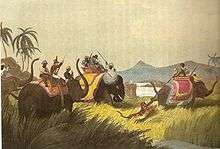
The tiger has been one of the big five game animals of Asia. Tiger hunting took place on a large scale in the early 19th and 20th centuries, being a recognised and admired sport by the British in colonial India as well as the maharajas and aristocratic class of the erstwhile princely states of pre-independence India. A single maharaja or English hunter could claim to kill over a hundred tigers in their hunting career.[62] Tiger hunting was done by some hunters on foot; others sat up on machans with a goat or buffalo tied out as bait; yet others on elephant-back.[162]
Man-eating tigers

Wild tigers that have had no prior contact with humans actively avoid interactions with humans. However, tigers cause more human deaths through direct attack than any other wild mammal.[62] Attacks are occasionally provoked, as tigers lash out after being injured while they themselves are hunted. Attacks can be provoked accidentally, as when a human surprises a tiger or inadvertently comes between a mother and her young,[163] or as in a case in rural India when a postman startled a tiger, used to seeing him on foot, by riding a bicycle.[164] Occasionally tigers come to view people as prey. Such attacks are most common in areas where population growth, logging, and farming have put pressure on tiger habitats and reduced their wild prey. Most man-eating tigers are old, are missing teeth, and are unable to capture their preferred prey.[57] For example, the Champawat Tiger, a tigress found in Nepal and then India, had two broken canines. She was responsible for an estimated 430 human deaths, the most attacks known to be perpetrated by a single wild animal, by the time she was shot in 1907 by Jim Corbett.[64] According to Corbett, tiger attacks on humans are normally in daytime, when people are working outdoors and are not keeping watch.[165] Early writings tend to describe man-eating tigers as cowardly because of their ambush tactics.[166]

Man-eaters have been a particular problem in recent decades in India and Bangladesh, especially in Kumaon, Garhwal and the Sundarbans mangrove swamps of Bengal, where some healthy tigers have hunted humans. Because of rapid habitat loss attributed to climate change, tiger attacks have increased in the Sundarbans.[168] The Sundarbans area had 129 human deaths from tigers from 1969 to 1971. In the 10 years prior to that period, about 100 attacks per year in the Sundarbans, with a high of around 430 in some years of the 1960s.[62] Unusually, in some years in the Sundarbans, more humans are killed by tigers than vice versa.[62] In 1972, India's production of honey and beeswax dropped by 50% when at least 29 people who gathered these materials were devoured.[62] In 1986 in the Sundarbans, since tigers almost always attack from the rear, masks with human faces were worn on the back of the head, on the theory that tigers usually do not attack if seen by their prey. This decreased the number of attacks only temporarily. All other means to prevent attacks, such as providing more prey or using electrified human dummies, worked less well.[169]
At least 27 people were killed or seriously injured by captive tigers in the United States from 1998 to 2001.[170][170]
In some cases, rather than being predatory, tiger attacks on human seem to be territorial in nature. At least in one case, a tigress with cubs killed eight people entering her territory without consuming them at all.[171]
Commercial hunting and traditional medicine
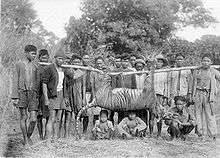
Historically, tigers have been hunted at a large scale so their famous striped skins could be collected. The trade in tiger skins peaked in the 1960s, just before international conservation efforts took effect. By 1977, a tiger skin in an English market was considered to be worth $4,250 US dollars.[62]
Many people in China and other parts of Asia have a belief that various tiger parts have medicinal properties, including as pain killers and aphrodisiacs.[172] There is no scientific evidence to support these beliefs. The use of tiger parts in pharmaceutical drugs in China is already banned, and the government has made some offences in connection with tiger poaching punishable by death. Furthermore, all trade in tiger parts is illegal under the Convention on International Trade in Endangered Species of Wild Fauna and Flora and a domestic trade ban has been in place in China since 1993.[173]
However, the trading of tiger parts in Asia has become a major black market industry and governmental and conservation attempts to stop it have been ineffective to date.[62] Almost all black marketers engaged in the trade are based in China and have either been shipped and sold within in their own country or into Taiwan, South Korea or Japan.[62] The Chinese subspecies was almost completely decimated by killing for commerce due to both the parts and skin trades in the 1950s through the 1970s.[62] Contributing to the illegal trade, there are a number of tiger farms in the country specialising in breeding the cats for profit. It is estimated that between 5,000 and 10,000 captive-bred, semi-tame animals live in these farms today.[174][175][176] However, many tigers for traditional medicine black market are wild ones shot or snared by poachers and may be caught anywhere in the tiger's remaining range (from Siberia to India to the Malay Peninsula to Sumatra). In the Asian black market, a tiger penis can be worth the equivalent of around $300 U.S. dollars. In the years of 1990 through 1992, 27 million products with tiger derivatives were found.[62] In July 2014 at an international convention on endangered species in Geneva, Switzerland, a Chinese representative admitted for the first time his government was aware trading in tiger skins was occurring in China.[177]
In captivity
In Ancient Roman times, tigers were kept in menageries and amphitheatres to be exhibited, trained and paraded, and were often provoked to fight humans and exotic beasts.[178][179] Since the 17th century, tigers, being rare and ferocious, were sought after to keep at European castles as symbols of their owners' power.[180] Tigers became central zoo and circus exhibits in the 18th century: a tiger could cost up to 4,000 francs in France (for comparison, a professor of the Beaux-Arts at Lyons earned only 3,000 francs a year),[181] or up to $3,500 in the United States where a lion cost no more than $1,000.[182]
China (2007) had over 4,000 captive tigers, of which 3,000 were held by about twenty larger facilities, with the rest held by some 200 smaller facilities.[183] The USA (2011) had 2,884 tigers in 468 facilities.[184] Nineteen states have banned private ownership of tigers, fifteen require a license, and sixteen states have no regulation.[185] Genetic ancestry of 105 captive tigers from fourteen countries and regions showed that forty-nine animals belonged distinctly to five subspecies; fifty-two animals had mixed subspecies origins.[186] As such, "many Siberian tigers in zoos today are actually the result of crosses with Bengal tigers."[187]
The Tiger Species Survival Plan has condemned the breeding of white tigers, alleging they are of mixed ancestry and of unknown lineage. The genes responsible for white colouration are represented by 0.001% of the population. The disproportionate growth in numbers of white tigers points to inbreeding among homozygous recessive individuals. This would lead to inbreeding depression and loss of genetic variability.[188]
Cultural depictions

%2C_Cizhou_yao_-_Hallwylska_museet_-_96218.tif.jpg)
Tigers and their superlative qualities have been a source of fascination for mankind since ancient times, and they are routinely visible as important cultural and media motifs. They are also considered one of the charismatic megafauna, and are used as the face of conservation campaigns worldwide. In a 2004 online poll conducted by cable television channel Animal Planet, involving more than 50,000 viewers from 73 countries, the tiger was voted the world's favourite animal with 21% of the vote, narrowly beating the dog.[189]

In myth and legend

In Chinese myth and culture, the tiger is one of the 12 animals of the Chinese zodiac. In Chinese art, the tiger is depicted as an earth symbol and equal rival of the Chinese dragon – the two representing matter and spirit respectively. The Southern Chinese martial art Hung Ga is based on the movements of the tiger and the crane. In Imperial China, a tiger was the personification of war and often represented the highest army general (or present day defense secretary),[190] while the emperor and empress were represented by a dragon and phoenix, respectively. The White Tiger (Chinese: 白虎; pinyin: Bái Hǔ) is one of the Four Symbols of the Chinese constellations. It is sometimes called the White Tiger of the West (西方白虎), and it represents the west and the autumn season.[190]
The tiger's tail appears in stories from countries including China and Korea, it being generally inadvisable to grasp a tiger by the tail.[191][192]
In Buddhism, the tiger is one of the Three Senseless Creatures, symbolising anger, with the monkey representing greed and the deer lovesickness.[190] The Tungusic peoples considered the Siberian tiger a near-deity and often referred to it as "Grandfather" or "Old man". The Udege and Nanai called it "Amba". The Manchu considered the Siberian tiger as Hu Lin, the king.[67] In Hinduism, the god Shiva wears and sits on tiger skin.[193] The ten-armed warrior goddess Durga rides the tigress (or lioness) Damon into battle. In southern India the god Ayyappan was associated with a tiger.[194]
The weretiger replaces the werewolf in shapeshifting folklore in Asia;[195] in India they were evil sorcerers, while in Indonesia and Malaysia they were somewhat more benign.[196] As per Hindu epic Mahabharata, tiger is more fiercer and ruthless than lion.[197]
In literature and film

In William Blake's poem in the Songs of Experience, titled "The Tyger," the tiger is a menacing and fearful animal. In Yann Martel's 2001 Man Booker Prize winning novel Life of Pi, the protagonist, surviving shipwreck for months in a small boat, somehow avoids being eaten by the other survivor, a large Bengal tiger. The story was adapted in Ang Lee's 2012 feature film of the same name. Jim Corbett's 1944 Man-Eaters of Kumaon tells ten true stories of his tiger-hunting exploits in what is now the northern Uttarakhand region of India. The book has sold over four million copies,[198] and has been the basis of both fictional and documentary films. In Rudyard Kipling's 1894 The Jungle Book, the tiger, Shere Khan, is the mortal enemy of the human protagonist, Mowgli; the book has formed the basis of both live-action and animated films. Other tiger characters aimed at children tend to be more benign, as for instance Tigger in A. A. Milne's Winnie-the-Pooh and Hobbes of the comic strip Calvin and Hobbes, both of whom are represented as simply stuffed animals come to life.
As a symbol

The tiger is one of the animals displayed on the Pashupati seal of the Indus Valley Civilisation. The tiger was the emblem of the Chola Dynasty and was depicted on coins, seals and banners.[199] The seals of several Chola copper coins show the tiger, the Pandyan emblem fish and the Chera emblem bow, indicating that the Cholas had achieved political supremacy over the latter two dynasties. Gold coins found in Kavilayadavalli in the Nellore district of Andhra Pradesh have motifs of the tiger, bow and some indistinct marks.[200] The tiger symbol of Chola Empire was later adopted by the Liberation Tigers of Tamil Eelam and the tiger became a symbol of the unrecognised state of Tamil Eelam and Tamil independence movement.[201]
The Bengal tiger is the national animal of India and Bangladesh.[202] The Malaysian tiger is the national animal of Malaysia.[203] The Siberian tiger is the national animal of South Korea. Since the successful economies of South Korea, Taiwan, Hong Kong and Singapore were described as the Four Asian Tigers, a tiger economy is a metaphor for a nation in rapid development. Tiger are also mascots for various sports teams around the world. Tony the Tiger is a famous mascot for Kellogg's breakfast cereal Frosted Flakes. The Esso (Exxon) brand of petrol was advertised from 1969 onwards with the slogan 'put a tiger in your tank', and a tiger mascot; more than 2.5 million synthetic tiger tails were sold to motorists, who tied them to their petrol tank caps.[204]
The tiger appears in heraldry but is distinct from the heraldic beast tyger, a wolflike, snouted creature which has its roots in European Medieval bestiaries.
See also
- 21st Century Tiger, information about tigers and conservation projects
- Animal track
- List of solitary animals
- Siegfried & Roy, two famous tamers of tigers
- Tiger in Chinese culture
- Tiger Temple, a Buddhist temple in Thailand famous for its tame tigers
- Tiger versus lion
- Man-Eaters of Kumaon
References
- 1 2 3 4 Chundawat, R.S.; Habib, B.; Karanth, U.; Kawanishi, K.; Ahmad Khan, J.; Lynam, T.; Miquelle, D.; Nyhus, P.; Sunarto, S.; Tilson, R.; et al. (2011). "Panthera tigris". IUCN Red List of Threatened Species. Version 2011.2. International Union for Conservation of Nature.
- 1 2 Dinerstein, E.; Loucks, C.; Wikramanayake, E.; Ginsberg, Jo.; Sanderson, E.; Seidensticker, J.; Forrest, J.; Bryja, G.; Heydlauff, A. (2007). "The Fate of Wild Tigers" (PDF). BioScience. 57 (6): 508–514. doi:10.1641/B570608. Archived from the original (PDF) on 25 April 2012.
- 1 2 (Latin)Linnaeus, C. (1758) Felis tigris In: Caroli Linnæi Systema naturæ per regna tria naturæ, secundum classes, ordines, genera, species, cum characteribus, differentiis, synonymis, locis. Tomus I. Halae Magdeburgicae. Page 41.
- ↑ David Krogh (2010), Biology: A Guide to the Natural World, Benjamin-Cummings, p. 658, ISBN 978-0-321-61655-5
- ↑ "Tiger Numbers Rise for First Time in a Century".
- ↑ John R. Platt. "Big News: Wild Tiger Populations are Increasing for the First Time in a Century". Scientific American Blog Network.
- ↑ Katy Daigle (10 April 2016). "World's wild tiger count rising for first time in a century". Phys Org. Retrieved 17 April 2016.
- ↑ Pocock, R.I. (1939) "Panthera tigris". In The Fauna of British India, Including Ceylon and Burma. Mammalia: Volume 1. Taylor and Francis, Ltd., London. pp. 197–210.
- ↑ Harper, D. (2001–2011). "Panther". Online Etymology Dictionary. Douglas Harper. Retrieved 24 October 2011.
- ↑ "tiger". The Free Dictionary. Farlex. Retrieved 6 April 2014.
- ↑ Harper, D. (2001–2011). "Tiger". Online Etymology Dictionary. Etymonline.com. Retrieved 6 April 2014.
- ↑ Johnson, W. E.; Eizirik, E.; Pecon-Slattery, J.; Murphy, W. J.; Antunes, A.; Teeling, E.; O'Brien, S. J. (2006). "The Late Miocene radiation of modern Felidae: A genetic assessment". Science. 311 (5757): 73–77. doi:10.1126/science.1122277. PMID 16400146.
- ↑ Davis, B. W.; Li G.; Murphy W. J. (2010). "Supermatrix and species tree methods resolve phylogenetic relationships within the big cats, Panthera (Carnivora: Felidae)". Molecular Phylogenetics and Evolution. 56 (1): 64–76. doi:10.1016/j.ympev.2010.01.036. PMID 20138224.
- ↑ Mazák, Ji H.; Christiansen, P.; Kitchener, A. C. (2011). "Oldest Known Pantherine Skull and Evolution of the Tiger". PLoS ONE. 6 (10): e25483. Bibcode:2011PLoSO...625483M. doi:10.1371/journal.pone.0025483. PMC 3189913
 . PMID 22016768.
. PMID 22016768. - ↑ Ostende, L. W. van den Hoek (1999). Javan Tiger – Ruthlessly hunted down. 300 Pearls – Museum highlights of natural diversity.
- ↑ Turner, Alan; Anton, Mauricio (1997). The Big Cats and Their Fossil Relatives.
- ↑ Piper, Philip J.; Ochoa, Janine; Lewis, Helen; Paz, Victor; Ronquillo, Wilfredo P. (2008). "The first evidence for the past presence of the tiger Panthera tigris (L.) on the island of Palawan, Philippines: Extinction in an island population". Palaeogeography, Palaeoclimatology, Palaeoecology. 264: 123–127. doi:10.1016/j.palaeo.2008.04.003.
- ↑ Cho, Y. S.; Hu, L.; Hou, H.; Lee, H.; Xu, J.; Kwon, S.; Oh, S.; Kim, H. M.; Jho, S.; Kim, S.; Shin, Y. A.; Kim, B. C.; Kim, H.; Kim, C. U.; Luo, S. J.; Johnson, W. E.; Koepfli, K. P.; Schmidt-Küntzel, A.; Turner, J. A.; Marker, L.; Harper, C.; Miller, S. M.; Jacobs, W.; Bertola, L. D.; Kim, T. H.; Lee, S.; Zhou, Q.; Jung, H. J.; Xu, X.; et al. (2013). "The tiger genome and comparative analysis with lion and snow leopard genomes". Nature Communications. 4: 2433. Bibcode:2013NatCo...4E2433C. doi:10.1038/ncomms3433. PMC 3778509
 . PMID 24045858.
. PMID 24045858. - ↑ Chundawat, R. S.; Khan, J. A.; Mallon, D. P. (2011). "Panthera tigris tigris". IUCN Red List of Threatened Species. Version 2011.2. International Union for Conservation of Nature.
- 1 2 Burke, Jason (20 January 2015). "India's tiger population increases by almost a third". The Guardian. Retrieved 3 May 2015.
- ↑ "Bhutan's tigers". World Wide Fund For Nature (WWF). Archived from the original on 2016-03-04. Retrieved 29 November 2015.
- 1 2 3 4 5 6 7 8 9 10 11 Mazák, V. (1981). "Panthera tigris" (PDF). Mammalian Species. 152: 1–8. doi:10.2307/3504004.
- ↑ Karanth, K. U. (2003). Tiger ecology and conservation in the Indian subcontinent. Journal of the Bombay Natural History Society 100 (2&3) 169–189.
- ↑ Bengal tigers have Smith, James L. David; Sunquist, Melvin E.; Tamang, Kirti Man; Rai, Prem Bahadur (1983). "A technique for capturing and immobilizing tigers". The Journal of Wildlife Management. 47 (1): 255–259. doi:10.2307/3808080. JSTOR 3808080. Table 1 entries on page 257 are Adult females N=19 mean=140 Range=116–164, Adult males N=7 mean=235 Range=200–261.
- 1 2 Brakefield, Tom (1993). Big Cats: Kingdom of Might. Voyageur Press. p. 44. ISBN 978-0-89658-329-0.
- ↑ "Species: Indochinese tiger". World Wildlife Fund. Retrieved 10 April 2014.
- 1 2 3 4 5 6 "Tiger Facts". Save China's Tigers. Archived from the original on 2014-08-29. Retrieved 10 April 2014.
- 1 2 "Lion City, Tiger Land: Singapore's Native Cat on the Brink of Extinction.". latitudes.nu. Retrieved 31 May 2016.
- ↑ Luo, S.-J.; Kim,J.-H.; Johnson, W. E.; van der Walt, J.; Martenson, J.; Yuhki, N.; Miquelle, D. G.; Uphyrkina, O.; Goodrich, J. M.; Quigley, H. B.; Tilson, R.; Brady, G.; Martelli, P.; Subramaniam, V.; McDougal, C.; Hean, S.; Huang, S.-Q.; Pan, W.; Karanth, U. K.; Sunquist, M.; Smith, J. L. D.; O'Brien, S. J. (2004). "Phylogeography and genetic ancestry of tigers (Panthera tigris)". PLoS Biology. 2 (12): e442. doi:10.1371/journal.pbio.0020442. PMC 534810
 . PMID 15583716.
. PMID 15583716. - ↑ "Species: Malayan tiger". World Wildlife Fund. Retrieved 10 April 2014.
- ↑ Hance, Jeremy (September 2014). "Malayan tiger population plunges to just 250-340 individuals". Mongabay.com. Retrieved 17 July 2016.
- ↑ Khan, M.K.M. (1986). "Tigers in Malaysia". Journal of Wildlife and Parks. V: 1–23.
- ↑ Kerley, L.L.; Goodrich, J.M. Miquelle; D.G. Smirnov; E.N. Quigley; H.G., Hornocker, M.G. (2003). "Reproductive parameters of wild female Amur (Siberian) tigers (Panthera tigris altaica)". Journal of Mammalogy. 84: 288–298. doi:10.1644/1545-1542(2003)084<0288:RPOWFA>2.0.CO;2. JSTOR 1383657.
- ↑ Kaiman, Jonathan (24 May 2013). "China reports rise in humans encountering wild Siberian tigers". The Guardian. Retrieved 10 April 2014.
- 1 2 Miquelle, D.; Darman, Y.; Seryodkin, I. (2011). "Panthera tigris ssp. altaica". IUCN Red List of Threatened Species. Version 2011.2. International Union for Conservation of Nature.
- ↑ "Species: Amur tiger". World Wildlife Fund. Retrieved 10 April 2014.
- ↑ "Russia Announce Tiger Census Results!". tigers.panda.org. World Wide Fund for Nature. 27 May 2015. Retrieved 7 June 2015.
- 1 2 Hammond, Paul (2010). The Atlas of Endangered Animals: Wildlife Under Threat Around the World. Marshall Cavendish. p. 86. ISBN 978-0-7614-7872-0.
- ↑ "South China tiger believed to still exist in wild". China.org.cn. Xinhua News Agency. 15 July 2007. Retrieved 3 April 2014.
- ↑ "Species: South China tiger". World Wildlife Fund. Retrieved 10 April 2014.
- ↑ Linkie, M.; Wibisono, H.T.; Martyr, D.J. & Sunarto, S. (2008). "Panthera tigris ssp. sumatrae (Sumatran Tiger)". IUCN Red List of Threatened Species. Version 2011.1. International Union for Conservation of Nature. Retrieved 9 August 2011.
- ↑ "Species: Sumatran tiger". World Wildlife Fund. Retrieved 10 April 2014.
- ↑ Cracraft, Joel; Feinstein, Julie; Vaughn, Jeffrey; Helm-Bychowski, Kathleen (1998). "Sorting out tigers (Panthera tigris): mitochondrial sequences, nuclear inserts, systematics, and conservation genetics" (PDF). Animal Conservation. 1 (2): 139–150. doi:10.1111/j.1469-1795.1998.tb00021.x.
- 1 2 3 4 5 Mazak, V. (2004). Der Tiger. Westarp Wissenschaften Hohenwarsleben. ISBN 3-89432-759-6. (in German)
- ↑ Whitten, Tony; Soeriaatmadja, Roehayat Emon (1996). Ecology of Java & Bali. Oxford University Press. p. 706. ISBN 978-962-593-072-5.
- ↑ Jackson, P.; Nowell, K. (2008). "Panthera tigris ssp. virgata". IUCN Red List of Threatened Species. Version 2011.2. International Union for Conservation of Nature.
- ↑ Driscoll, C. A.; Yamaguchi, N.; Bar-Gal, G. K.; Roca, A. L.; Luo, S.; MacDonald, D. W.; O'Brien, S. J. (2009). Brembs, Björn, ed. "Mitochondrial Phylogeography Illuminates the Origin of the Extinct Caspian Tiger and Its Relationship to the Amur Tiger". PLoS ONE. 4 (1): e4125. doi:10.1371/journal.pone.0004125. PMC 2624500
 . PMID 19142238.
. PMID 19142238. - ↑ Jackson, P.; Nowell, K. (2008). "Panthera tigris ssp. sondaica". IUCN Red List of Threatened Species. Version 2011.2. International Union for Conservation of Nature.
- ↑ Mazák, J.H.; Groves, C.P. (2006). "A taxonomic revision of the tigers (Panthera tigris)" (PDF). Mammalian Biology. 71 (5): 268–287. doi:10.1016/j.mambio.2006.02.007. Archived from the original (PDF) on 6 September 2007.
- ↑ Seidensticker, J. (1987). "Bearing Witness: Observations on the Extinction of Panthera tigris balica and Panthera tigris sondaica". pp. 1–8 in: Tilson, R. L., Seal, U. S. (eds.) Tigers of the World: the biology, biopolitics, management, and conservation of an endangered species. Noyes Publications, New Jersey, ISBN 0-8155-1133-7.
- ↑ Istiadi, Y.; Panekenan, N.; Priatna, D.; Novendri, Y.; Mathys, A.; Mathys, Y. (1991). "Untersuchung über die Carnivoren des Gunung Halimun Naturschutzgebietes.". Zoologische Gesellschaft für Arten- und Populationsschutz e.V. Mitteilungen. 7 (2): 3–5.
- ↑ Wilting, A.; Courtiol, A.; Christiansen, P.; Niedballa, J.; Scharf, A. K.; Orlando, L.; Balkenhol, N.; Hofer, H.; Kramer-Schadt, S.; Fickel, J.; Kitchener, A. C. (2015). "Planning tiger recovery: Understanding intraspecific variation for effective conservation". Science Advances. Science Advances. 11 (5: e1400175): e1400175. doi:10.1126/sciadv.1400175.
- ↑ Kupferschmidt, K. (2015). "Controversial study claims there are only two types of tiger". American Association for the Advancement of Science. doi:10.1126/science.aac6905. Retrieved 27 June 2015.
- 1 2 Guggisberg, C. A. W. (2001). Wild Cats of the World. New Library Press. ISBN 978-0-7950-0128-4.
- 1 2 Markel, Scott; León, Darryl (2003). Sequence Analysis in a Nutshell: a guide to common tools and databases. Sebastopol, California: O'Reily. ISBN 0-596-00494-X.
- ↑ "tigon – Encyclopædia Britannica Article". Retrieved 12 September 2007.
- 1 2 3 4 5 Miquelle, Dale. "Tiger". In MacDonald, David. The Encyclopedia of Mammals (2nd ed.). Oxford University Press. pp. 18–21. ISBN 0-7607-1969-1.
- ↑ Godfrey D.; Lythgoe J. N.; Rumball D. A. (1987). "Zebra stripes and tiger stripes: the spatial frequency distribution of the pattern compared to that of the background is significant in display and crypsis". Biological Journal of the Linnean Society. 32 (4): 427–433. doi:10.1111/j.1095-8312.1987.tb00442.x.
- ↑ Allen, William, L.; Cuthill, Innes, C.; Scott-Samuel, Nicholas E.; Baddeley, Roland (2010). "Why the leopard got its spots: relating pattern development to ecology in felids". Proceedings of the Royal Society B. 278 (1710): 1373–1380. doi:10.1098/rspb.2010.1734. PMC 3061134
 . PMID 20961899.
. PMID 20961899. - 1 2 3 Schaller, G. (1967). The Deer and the Tiger: A Study of Wildlife in India. Chicago: Chicago Press.
- ↑ Geptner, V. G., Sludskii, A. A. (1972) Mlekopitaiuščie Sovetskogo Soiuza. Vysšaia Škola, Moskva. (In Russian; English translation: Heptner, V. G.; Sludskii, A. A.; Bannikov, A. G.; (1992) Mammals of the Soviet Union. Volume II, Part 2: Carnivora (Hyaenas and Cats). Smithsonian Institution and the National Science Foundation, Washington DC). pp. 95–202.
- 1 2 3 4 5 6 7 8 9 10 11 12 13 14 15 16 17 18 19 20 21 22 23 24 25 Novak, R. M. (1999). Walker's Mammals of the World (6th ed.). Baltimore: Johns Hopkins University Press. ISBN 0-8018-5789-9.
- 1 2 Brakefield, T. (1993). Big Cats: Kingdom of Might. Voyageur Press. ISBN 0-89658-329-5.
- 1 2 3 Wood, Gerald (1983). The Guinness Book of Animal Facts and Feats. Guinness Superlatives. ISBN 978-0-85112-235-9.
- ↑ Hunter, Luke (2011). Carnivores of the World. Princeton University Press. ISBN 978-0-691-15228-8.
- ↑ Conover, Adele (November 1995). "The object at hand". Smithsonian Magazine. Retrieved 7 April 2014.
- 1 2 3 Matthiessen, Peter; Hornocker, Maurice (2001). Tigers In The Snow. North Point Press. ISBN 0-86547-596-2.
- 1 2 Begany, Lauren; Criscuolo, C.L. (27 April 2009). "Accumulation of Deleterious Mutations Due to Inbreeding in Tiger Population" (PDF). Archived from the original (PDF) on 2015-05-10.
- ↑ Xu, X.; Dong, G. X.; Hu, X. S.; Miao, L.; Zhang, X. L.; Zhang, D. L.; Yang, H. D.; Zhang, T. Y.; Zou, Z. T.; Zhang, T. T.; Zhuang, Y.; Bhak, J.; Cho, Y. S.; Dai, W. T.; Jiang, T. J.; Xie, C.; Li, R.; Luo, S. J. (2013). "The Genetic Basis of White Tigers". Current Biology. 23 (11): 1031–5. doi:10.1016/j.cub.2013.04.054. PMID 23707431.
- ↑ "White tiger facts". Indian Tiger Welfare Society. 2009. Retrieved 3 April 2014.
- ↑ Tucker, Linda (2010). Mystery of the White Lions. Hay House. p. 280. ISBN 1-4019-2721-1.
- 1 2 Shuker, Karl P N (1989). Mystery Cats of the World. Robert Hale. ISBN 0-7090-3706-6.
- 1 2 McDougal, C. (1977) The Face of the Tiger. Rivington Books and André Deutsch, London.
- ↑ Piper, P.J.; Earl of Cranbrook, Rabett, R.J. (2007). "Confirmation of the presence of the tiger Panthera tigris (L.) in Late Pleistocene and Holocene Borneo". Malayan Nature Journal. 59 (3): 259–267.
- ↑ Piper, P.J., Philip J.; Ochoa, J.; Paz, V.; Lewis, H.; Ronquillo, W.P. (2008). "The first evidence for the past presence of the tiger Panthera tigris (L.) on the island of Palawan, Philippines: extinction in an island population". Palaeogeography, Palaeoclimatology, Palaeoecology. 264: 123–127. doi:10.1016/j.palaeo.2008.04.003.
- ↑ Sanderson, E., Forrest, J., Loucks, C., Ginsberg, J., Dinerstein, E., Seidensticker, J., Leimgruber, P., Songer, M., Heydlauff, A., O'Brien, T., Bryja, G., Klenzendorf, S., Wikramanayake, E. (2006). The Technical Assessment: Setting Priorities for the Conservation and Recovery of Wild Tigers: 2005–2015. WCS, WWF, Smithsonian, and NFWF-STF, New York and Washington, DC, USA.
- ↑ "Tiger". Smithsonian National Zoological Park. Retrieved 7 April 2014.
- ↑ Shoemaker, A.H., Maruska, E.J. and R. Rockwell (1997) Minimum Husbandry Guidelines for Mammals: Large Felids. American Association of Zoos and Aquariums
- 1 2 3 4 Mills, S. (2004). Tiger. London: BBC Books. p. 89. ISBN 1-55297-949-0.
- ↑ Burger, B. V.; Viviers, M. Z.; Bekker, J. P. I.; Roux, M.; Fish, N.; Fourie, W. B.; Weibchen, G. (2008). "Chemical Characterization of Territorial Marking Fluid of Male Bengal Tiger, Panthera tigris". Journal of Chemical Ecology. 34 (5): 659–671. doi:10.1007/s10886-008-9462-y. PMID 18437496.
- ↑ Smith, J. L. David; McDougal, C.; Miquelle, D. (1989). "Scent marking in free-ranging tigers, Panthera tigris". Animal Behaviour. 37: 1–10. doi:10.1016/0003-3472(89)90001-8.
- ↑ "About:Tiger (Panthera tigris)". Arkive.org. Wildscreen UK. Retrieved 10 April 2014.
- ↑ Wildlife Conservation Society. (2015). Tiger dad: Rare family portrait of Amur tigers the first-ever to include an adult male. ScienceDaily, 6 March 2015.
- ↑ "T-25 Dollar Dominant Male Tiger in Ranthambore National Park".
- ↑ Mishra, S. (2012). Check out that fatherly instinct! Ferocious male tiger nicknamed 'cruel' adopts and raises two orphaned cubs at Ranthambore. Daily Mail, 11 November 2012.
- 1 2 Thapar, Valmik (1989). Tiger: Portrait of a Predator. New York: Smithmark. ISBN 0-8160-1238-5.
- ↑ Peters, G.; Tonkin-Leyhausen, B. A. (1999). "Evolution of Acoustic Communication Signals of Mammals: Friendly Close-Range Vocalizations in Felidae (Carnivora)". Journal of Mammalian Evolution. 6 (2): 129–159. doi:10.1023/A:1020620121416.
- ↑ Karanth, K.U.; Nichols, J.D.; Seidensticker, J.; Dinerstein, E.; Smith, J.L.D.; McDougal, C.; Johnsingh, A.J.T.; Chundawat, R.S. (2003). "Science deficiency in conservation practice: the monitoring of tiger populations in India". Animal Conservation. 6 (2): 141–146. doi:10.1017/S1367943003003184. hdl:10088/338.
- ↑ Gopalaswamy, Arjun M.; Royle, J. Andrew; Delampady, Mohan; Nichols, James D.; Karanth, K. Ullas; Macdonald, David W. (July 2012). "Density estimation in tiger populations: combining information for strong inference". Ecology. 93 (7): 1741–1751. doi:10.1890/11-2110.1. JSTOR 23225238.
- ↑ Caragiulo, A.; Pickles, R. S. A.; Smith, J. A.; Smith, O.; Goodrich, J.; Amato, G. (2015). "Tiger (Panthera tigris) scent DNA: a valuable conservation tool for individual identification and population monitoring". Conservation Genetics Resources. 7: 681–683. doi:10.1007/s12686-015-0476-9.
- 1 2 3 4 5 Ramesh, T.; Snehalatha, V.; Sankar, K. & Qureshi, Qamar (2009). "Food habits and prey selection of tiger and leopard in Mudumalai Tiger Reserve, Tamil Nadu, India". J. Sci. Trans. Environ. Technov. 2 (3): 170–181.
- ↑ Karanth, K. Ullas & Sunquist, Melvin E. (1995). "Prey Selection by Tiger, Leopard and Dhole in Tropical Forests". Journal of Animal Ecology. 64 (4): 439–450. doi:10.2307/5647. JSTOR 5647.
- ↑ Karanth, K.U. & Sunquist, M.E (2009). "Prey selection by tiger, leopard and dhole in tropical forests". Journal of Animal Ecology. 64 (3): 439–450. doi:10.2307/5647.
- ↑ Andheria, A.P.; Karanth, K.U.; Kumar, N.S. (2007). "Diet and prey profiles of three sympatric large carnivores in Bandipur Tiger Reserve, India". Journal of Zoology. 273 (2): 169–175. doi:10.1111/j.1469-7998.2007.00310.x. (subscription required (help)).
- ↑ Miquelle, Dale G.; Smirnov, Evgeny N.; Quigley, Howard B.; Hornocker, Maurice G.; Nikolayev, Igor G. & Matyushkin, Evgeny N. (1996). "Food habits of Amur tigers in the Sikhote-Alin Zapovednik and the Russian Far East, and implications for conservation" (PDF). Journal of Wildlife Research. 1 (2): 138. Archived from the original (PDF) on 1 November 2012.
- ↑ David Prynn (2004). Amur tiger. Russian Nature Press. p. 115.
- ↑ Seryodkin; et al. (2003). "Denning ecology of brown bears and Asiatic black bears in the Russian Far East". Ursus. 14 (2): 159.
- ↑ Seryodkin I. V.; Goodrich J. M.; Kostyrya A. V.; Schleyer B. O.; Smirnov E. N.; Kerley L. L.; Miquelle D. G. (2005). "19". Relationship among tigers, brown bears, and Himalayan black bears. Tigers of Sikhote-Alin Zapovednik: Ecology and Conservation.
- ↑ Linkie, M.; Ridout, M. S. (2011). "Assessing tiger-prey interactions in Sumatran rainforests". Journal of Zoology. 284 (3): 224–229. doi:10.1111/j.1469-7998.2011.00801.x.
- ↑ Cawthon Lang KA (13 June 2005). "Primate Factsheets: Orangutan (Pongo) Taxonomy, Morphology, & Ecology". Retrieved 12 October 2007.
- ↑ "Trouble for rhino from poacher and Bengal tiger". The Telegraph. 2008.
- ↑ "Tiger kills elephant at Eravikulam park". The New Indian Express. 2009.
- ↑ Karanth, K. U. & Nichols, J. D. (1998). "Estimation of tiger densities in India using photographic captures and recaptures" (PDF). Ecology. 79 (8): 2852–2862. doi:10.1890/0012-9658(1998)079[2852:EOTDII]2.0.CO;2. JSTOR 176521.
- ↑ Frank Leslie's popular monthly, Volume 45, 1879, edited by Frank Leslie, New York: Frank Leslie's Publishing House. 53, 55, & 57 Park Place. p. 411
- 1 2 3 4 Perry, Richard (1965). The World of the Tiger. p. 260.
- ↑ Bright, Michael (2002). Man-Eaters. Macmillan. pp. 53–54. ISBN 0-312-98156-2.
- ↑ Tilson, Ronald (2010). Tigers of the World: The Science, Politics and Conservation of Panthera tigris. Elsevier Inc. p. 22. ISBN 978-0-8155-1570-8.
- ↑ Tiger: Spy In The Jungle. John Downer Productions. BBC (2008)
- ↑ Dacres, Kevin (2007). "Panthera tigris". Animal Diversity Web. Retrieved 3 April 2014.
- ↑ Tilson, Ronald (2010). Tigers of the World: The Science, Politics and Conservation of Panthera tigris. Elsevier Inc. p. 23. ISBN 978-0-8155-1570-8.
- ↑ Sankhala, p. 17
- ↑ Hunter, Luke (2011). Carnivores of the World. Princeton University Press. ISBN 978-0-691-15228-8.
- ↑ Heptner, V.G. & Sludskii, A.A. (1992). Mammals of the Soviet Union Volume II, Part 2. ISBN 90-04-08876-8.
- 1 2 Sunquist, M., Sunquist, F. (2002) Wild Cats of the World. University Of Chicago Press, Chicago
- ↑ Sankhala, p. 23
- 1 2 Mills, Stephen (2004). Tiger. Richmond Hill, Ontario.: Firefly Books. p. 168. ISBN 1-55297-949-0.
- 1 2 Thapar, Valmik (1992). The Tiger's Destiny. London: Kyle Cathie. ISBN 1-85626-142-5.
- ↑ "Tiger". Oaklandzoo.org. Archived from the original on 25 October 2010. Retrieved 7 March 2009.
- ↑ Sunquist, Fiona & Sunquist, Mel (2002). Tiger Moon. University of Chicago Press. ISBN 0-226-77997-1.
- ↑ Mills, Gus; Hofer, Heribert (1998). Hyaenas: status survey and conservation action plan. IUCN/SSC Hyena Specialist Group. ISBN 2-8317-0442-1.
- ↑ Miquelle, D.G., Stephens, P.A., Smirnov, E.N., Goodrich, J.M., Zaumyslova, O.Yu. & Myslenkov, A.I. (2005). Tigers and Wolves in the Russian Far East: Competitive Exclusion, Functional Redundancy and Conservation Implications. In Large Carnivores and the Conservation of Biodiversity. Ray, J.C., Berger, J., Redford, K.H. & Steneck, R. (eds.) New York: Island Press. pp. 179–207 ISBN 1-55963-080-9.
- ↑ Heptner, V. G. & A.A. Sludskii (1992). Mammals of the Soviet Union, Volume II, Part 2. Leiden: Brill. p. 177. ISBN 90-04-08876-8.
- ↑ Goldsmith, O. (2010). A History Of The Earth, And Animated Nature, Volume 2. Nabu Press. p. 297. ISBN 1-145-11108-4.
- ↑ Mills, Stephen (2004). Tiger. Richmond Hill., Ont.: Firefly Books. p. 168. ISBN 1-55297-949-0.
- ↑ "Sympatric Tiger and Leopard: How two big cats coexist in the same area". Archived from the original on 13 February 2008.Ecology.info
- 1 2 Karanth, K. Ullas; Sunquist, Melvin E. (2000). "Behavioural correlates of predation by tiger (Panthera tigris), leopard (Panthera pardus) and dhole (Cuon alpinus) in Nagarahole, India". Journal of Zoology. 250 (2): 255–265. doi:10.1111/j.1469-7998.2000.tb01076.x.
- ↑ Sillero-Zubiri, C., Hoffmann, M. and Macdonald, D.W. (eds). 2004. Canids: Foxes, Wolves, Jackals and Dogs. Status Survey and Conservation Action Plan. IUCN/SSC Canid Specialist Group. Gland, Switzerland and Cambridge, UK. ISBN 2-8317-0786-2
- ↑ Big News: Wild Tiger Populations are Increasing for the First Time in a Century (Scientific American, April 10, 2016)
- 1 2 Chundawat, R.S.; Habib, B.; Karanth, U.; Kawanishi, K.; Ahmad Khan, J.; Lynam, T.; Miquelle, D.; Nyhus, P.; Sunarto, S.; Tilson, R.; et al. (2010). "Panthera tigris". IUCN Red List of Threatened Species. Version 2011.2. International Union for Conservation of Nature.
- ↑ "Tiger". Big Cat Rescue. Retrieved 7 March 2009.
- ↑ "Tigers 'take night shift' to dodge humans". BBC News. 4 September 2012. Retrieved 10 April 2014.
- ↑ "Traditional Chinese Medicine". World Wildlife Foundation. Archived from the original on 2012-05-11. Retrieved 3 March 2012.
- ↑ Jacobs, Andrew (13 February 2010). "Tiger Farms in China Feed Thirst for Parts". New York Times.
- ↑ WWF – Tiger – Overview. Worldwildlife.org (10 August 2011). Retrieved on 27 September 2011.
- ↑ Plumer, Brad (2016-04-11). "Wild tiger populations are rebounding for the first time in a century". Vox. Retrieved 2016-04-11.
- ↑ Rabinowitz, A. (Autumn 2009). "Stop the bleeding: implementing a strategic Tiger Conservation Protocol" (PDF). CatNews. IUCN (51): 30–31. ISSN 1027-2992. Archived from the original (PDF) on 2012-11-09.
- ↑ Hoiberg, Dale & Ramchandani, Indu (2000). Students' Britannica India. Popular Prakashan. ISBN 978-0-85229-760-5. Retrieved 10 June 2010.
- ↑ Independent Online (12 March 2008). "'World tiger population shrinking fast'". Iol.co.za. Archived from the original on 18 July 2010. Retrieved 10 June 2010.
- ↑ Dinerstein, E., Loucks, C., Heydlauff, A., Wikramanayake, E., Bryja, G., Forrest, J., Ginsberg, J., Klenzendorf, S., Leimgruber, P., O'Brien, T., Sanderson, E., Seidensticker, J., Songer, M. (2006) Setting Priorities for the Conservation and Recovery of Wild Tigers: 2005–2015. A User's Guide. 1–50. Washington, D.C., New York, WWF, WCS, Smithsonian, and NFWF-STF.
- ↑ "Front Page : Over half of tigers lost in 5 years: census". The Hindu. 13 February 2008. Retrieved 10 June 2010.
- ↑ Page, Jeremy (5 July 2008). "Tigers flown by helicopter to Sariska reserve to lift numbers in western India". London: The Times. Retrieved 25 May 2010.
- ↑ "India Reports Sharp Decline in Wild Tigers". News.nationalgeographic.com. Retrieved 10 June 2010.
- ↑ "It's the tale of a tiger, two tigresses in wilds of Sariska". Economictimes.indiatimes.com. 2 March 2009. Retrieved 10 June 2010.
- ↑ "Tigers galore in Ranthambhore National Park". Hindu.com. 11 March 2009. Retrieved 10 June 2010.
- ↑ Goodrich, J.M.; Miquelle, D.G.; Smirnov, E.M.; Kerley, L.L.; Quigley, H.B.; Hornocker, M.G. (2010). "Spatial structure of Amur (Siberian) tigers (Panthera tigris altaica) on Sikhote-Alin Biosphere Zapovednik, Russia". Journal of Mammalogy. 91 (3): 737–748. doi:10.1644/09-mamm-a-293.1.
- ↑ "Amur (Siberian) tiger". World Wildlife Fund. Archived from the original on 2013-11-25. Retrieved 19 December 2007.
- ↑ Timothy, E.; Fulbright, D.; Hewitt, G. (2007). Wildlife Science: Linking Ecological Theory and Management Applications. CRC Press. ISBN 0-8493-7487-1.
- ↑ Yeh, Emily T. (2012). "Transnational Environmentalism and Entanglements of Sovereignty: The Tiger Campaign Across the Himalayas". Political Geography. 31: 408–418. doi:10.1016/j.polgeo.2012.06.003.
- ↑ "Animal Skin Clothes Burned In Tibet After Dalai Lamas Call". The Office of His Holiness the Dalai Lama. 17 February 2006. Retrieved 4 December 2010.
- ↑ Franklin, N., Bastoni, Sriyanto, Siswomartono, D., Manansang, J. and R. Tilson (1999). Last of the Indonesian tigers: a cause for optimism, pp. 130–147 in: Seidensticker, J., Christie, S. and Jackson, P. (eds). Riding the tiger: tiger conservation in human-dominated landscapes. Cambridge University Press, Cambridge, ISBN 0-521-64835-1.
- ↑ Tilson, R. (1999). Sumatran Tiger Project Report No. 17 & 18: July − December 1999. Grant number 1998-0093-059. Indonesian Sumatran Tiger Steering Committee, Jakarta.
- ↑ Nyhus, P., Sumianto and R. Tilson (1999). The tiger-human dimension in southeast Sumatra, pp. 144–145 in: Seidensticker, J., Christie, S. and Jackson, P. (eds). Riding the tiger: tiger conservation in human-dominated landscapes. Cambridge University Press, Cambridge, ISBN 0-521-64835-1.
- ↑ Singh, A. (1981) Tara, a tigress. Quartet Books, London and New York ISBN 0-7043-2282-X.
- ↑ Menon, S. (1997). Tainted Royalty. India Today (17 November 1997).
- ↑ Bagla, P. (19 November 1998). Indian tiger isn't 100 per cent "swadeshi". The Indian Express.
- ↑ Shankaranarayanan, P.; Singh, L. (1998). "Mitochondrial DNA sequence divergence among big cats and their hybrids". Current Science. 75 (9): 919–923.
- ↑ Singh, R.K. (2000). Tara: The Cocktail Tigress. Print World, Allahabad.
- ↑ Warren, Jane (5 October 2010). "Tiger cubs saved by catwoman". Express.co.uk. Retrieved 12 December 2010.
- ↑ "Big Cat Swap Raises Questions". Institute for War and Peace Reporting. 19 May 2010. Retrieved 30 October 2015.
- ↑ "Russian tigers to take their stripes to Iran". RT. 28 February 2012. Archived from the original on 2016-01-28. Retrieved 4 January 2016.
- ↑ Ewan Palmer (1 March 2012). "Russia Sends Siberian Tigers to Iran to Save Species". International Business Times. Retrieved 23 January 2016.
- ↑ Royal Tiger (nom-de-plume) in The Manpoora Tiger – about a Tiger Hunt in Rajpootanah. (1836) Bengal Sporting Magazine, Vol IV. reproduced in The Treasures of Indian Wildlife
- ↑ Singh, Kesri (1959). The tiger of Rajasthan. Hale.
- ↑ Byrne, Peter (2002). Shikari Sahib. Pilgrims Publishing. pp. 291–292. ISBN 81-7769-183-X.
- ↑ Jim Corbett, Man-Eaters of Kumaon, Oxford University Press, 1944
- ↑ The Man-Eater of Segur", from Nine Man-Eaters and One Rogue, Kenneth Anderson, Allen & Unwin, 1954
- ↑ "Famous 'man-eater' at Calcutta". Underwood & Underwood. 1903. Retrieved 9 April 2014.
- ↑ "Climate change linked to Indian tiger attacks". Environmental News Network. 20 October 2008. Retrieved 27 October 2008.
- ↑ Montgomery, Sy (2009). Spell of the Tiger: The Man-Eaters of Sundarbans. Chelsea Green Publishing. pp. 37–38. ISBN 0-395-64169-1.
- 1 2 Nyhus, P.J.; Tilson, R.L.; Tomlinson, J.L. (2003). "Dangerous animals in captivity: Ex situ tiger conflict and implications for private ownership of exotic animals". Zoo Biology. 22 (6): 573–586. doi:10.1002/zoo.10117.
- ↑ Ethirajan, A. (2012). "Rogue tigress 'terrorises Bangladesh villagers'". BBC News. BBC.
- ↑ Harding, Andrew (23 September 2006). "Beijing's penis emporium". BBC News. Retrieved 7 March 2009.
- ↑ Nowell, K. (2007). "Asian big cat conservation and trade control in selected range States: evaluating implementation and effectiveness of CITES Recommendations" (PDF). TRAFFIC International. Retrieved 3 April 2014.
- ↑ "Chinese tiger farms must be investigated". WWF. 24 April 2007. Archived from the original on 5 July 2007. Retrieved 7 March 2009.
- ↑ "WWF: Breeding tigers for trade soundly rejected at CITES". Panda.org. 13 June 2007. Archived from the original on 17 March 2008. Retrieved 7 March 2009.
- ↑ Jackson, Patrick (29 January 2010). "Tigers and other farmyard animals". BBC News. Retrieved 29 January 2010.
- ↑ "Conservationists shocked by Chinese admission of tiger skin selling". Shanghai Sun. Retrieved 12 July 2014.
- ↑ Auguet, Roland (1994). Cruelty and civilization: the Roman games. Psychology Press. pp. 83–85. ISBN 978-0-415-10453-1.
- ↑ Baker, William (1988). Sports in the Western World. University of Illinois Press. p. 33. ISBN 0-252-06042-3.
- ↑ Baratay, Eric (2004). Zoo: A History of Zoological Gardens in the West. Reaktion Books. p. 19. ISBN 978-1-86189-208-9.
- ↑ Baratay, Eric (2004). Zoo: A History of Zoological Gardens in the West. Reaktion Books. p. 122. ISBN 978-1-86189-208-9.
- ↑ Ruppel, Louis (1951). "Collier's, Volume 127". Crowell-Collier Publishing Company: 61.
- ↑ Nowell, K., Ling, X. (2007) Taming the tiger trade: China's markets for wild and captive tiger products since the 1993 domestic trade ban. TRAFFIC East Asia, Hong Kong, China.
- ↑ Wildlife Watch, Group (2011). "Less than 3,000 Pet Tigers in America". Wildlife Times. 5 (37): 12–13.
- ↑ "Summary of State Laws Relating to Private Possession of Exotic Animals". Born Free USA. Retrieved 12 December 2010.
- ↑ Luo,S.; Johnson,W. E.; Martenson, J.; Antunes, A.; Martelli, P.; Uphyrkina, O.; Traylor-Holzer, K.; Smith, J. L.D.; O'Brien, S. J. (2008). "Subspecies Genetic Assignments of Worldwide Captive Tigers Increase Conservation Value of Captive Populations" (PDF). Current Biology. 18 (8): 592–596. doi:10.1016/j.cub.2008.03.053. PMID 18424146. Archived from the original (PDF) on 25 April 2012.
- ↑ Sanderson, James; Moulton, Michael (18 August 1998). Wildlife Issues in a Changing World (Second ed.). CRC Press. p. 133. ISBN 9781439832622.
- ↑ Xavier, N. (2010). "A new conservation policy needed for reintroduction of Bengal tiger-white". Current Science. 99 (7): 894–895.
- ↑ "Endangered tiger earns its stripes as the world's most popular beast". The Independent. 6 December 2004. Retrieved 7 March 2009.
- 1 2 3 Cooper, JC (1992). Symbolic and Mythological Animals. London: Aquarian Press. pp. 161–62. ISBN 1-85538-118-4.
- ↑ "Tiger's Tail". Cultural China. Retrieved 29 March 2014.
- ↑ Chan-eung, Par (1999). A Tiger by the tail and other Stories from the heart of Korea. Libraries Unlimited.
- ↑ SIVKISHEN (17.07.2014) Kingdom of Shiva, PartridgeIndia, p. 301.
- ↑ Balambal, V (1997). "19. Religion – Identity – Human Values – Indian Context". Bioethics in India: Proceedings of the International Bioethics Workshop in Madras: Biomanagement of Biogeoresources, 16–19 January 1997. Eubios Ethics Institute. Retrieved 8 October 2007.
- ↑ Summers, Montague (1966). The Werewolf. University Books. p. 21. ISBN 0-517-18093-6.
- ↑ Newman, Patrick (2012). Tracking the Weretiger: Supernatural Man-Eaters of India, China and Southeast Asia. McFarland. pp. 96–102. ISBN 978-0-7864-7218-5.
- ↑ Prof. Muneo Tokunaga John D. Smith K M Ganguli. "Tiger in Hindu epic Mahabharatha". The Mahabharata in Sanskrit. Sacred Texts. pp. SECTION LXVIII. Retrieved June 15, 2016.
- ↑ Booth, Martin (1991) Carpet Sahib; A Life of Jim Corbett, New York: Oxford University Press, ISBN 0-19-282859-2, p. 230.
- ↑ Hermann Kulke, K Kesavapany, Vijay Sakhuja (2009) Nagapattinam to Suvarnadwipa: Reflections on the Chola Naval Expeditions to Southeast Asia,Institute of Southeast Asian Studies, p. 84.
- ↑ Singh, U. (2008). A History of Ancient and Early Medieval India: From the Stone Age to the 12th Century. Pearson Education, India.
- ↑ Daya Somasundaram (11.02.2014) Scarred Communities: Psychosocial Impact of Man-made and Natural Disasters on Sri Lankan Society, SAGE Publications India, p. 73.
- ↑ "National Animal". Government of India Official website. Archived from the original on 2012-05-11.
- ↑ DiPiazza, F. (2006). Malaysia in Pictures. Twenty-First Century Books. p. 14. ISBN 978-0-8225-2674-2.
- ↑ "The history of advertising in quite a few objects: 43 Esso tiger tails". Campaign. 27 September 2012. Retrieved 29 March 2014.
Bibliography
- Sankhala, Kailash (1997). Indian Tiger. Roli Books Pvt Limited, India. ISBN 978-81-7437-088-4.
External links
| Wikiquote has quotations related to: Tigers |
| Wikimedia Commons has media related to: |
| Wikispecies has information related to: Panthera tigris |
- Species portrait Tiger; IUCN/SSC Cat Specialist Group
- Biodiversity Heritage Library bibliography for Panthera tigris
- Tiger Stamps: Tiger images on postage stamps from many different countries
- Year of the tiger. Video collection on occasion of the Year of the Tiger, 2010. BBC.
- Video clips. BBC archive on Wildlife Finder.
- "Is this the last chance to save the tiger?". 19 November 2010. By Pralad Yonzon. The Kathmandu Post.
- Tale of the Cat at the Wayback Machine (archived 26 February 2010). 1 March 2010. By Andrew Marshall. TIME Magazine
- "India's tiger population increases by 30% in past three years; country now has 2,226 tigers". 20 January 2015. By Vishwa Mohan. Times of India. Retrieved 17 July 2016.
